How To Use Amaco Bisque Fix
If you lot've come over from NCECA Minneapolis, welcome! In this postal service I'll be detailing my procedure of testing nine commercial bisque-mend compounds. This will exist a lengthy postal service describing all nine materials and their performance though each step of testing, with pictures. If you lot want to skip over the examination process and get direct to the results, caput to this post.
Before I begin I need to thank my partner in this testing venture, TJ Erdahl. He contacted the manufacturers of these compounds, who were all generous enough to send me free production for this testing project. Naturally, I as well desire to thank Amaco, Archie Bray, Apt II, Marx, The Ceramic Shop in Philadelphia, Duncan, and Spectrum for sending me their products. Clicking on the links above will accept you to the product page for materials I tested. I will as well post product links subsequently in this mail service, since both Marx and The Ceramic Shop sent ii mending products.
I set up my test to cover five things: filling a fissure at the green stage, re-attachment of breakage at the green stage, filling a scissure at the bisque stage, re-zipper of breakage at the bisque stage, and how the production looked when covered with a black underglaze that I use in my piece of work. I did not apply glaze over any of these tests. I bisqued all products to cone 06, and glaze fired to cone 6, with the exception of Duncan, a low fire product. It was fired to cone 04. All firings were done in a Skutt electric kiln using the "boring" speed setting. All tests were washed using a bootleg white stoneware clay with a 14% compress rate. If you plan to apply whatsoever of these products, I recommend doing your own testing to run into how the production responds to your dirt body, glazes, and firing schedule. I hope y'all tin use my test efforts as a springboard to aid decide if whatever of these products can benefit your ain studio do.
In lodge to test all of the factors I listed higher up, I made small body of water lion figures which I purposely constructed poorly (a very odd feeling!), in order to encourage cracking and breakage. Each ocean lion was cutting in half and shoddily re-joined, to brand certain there would be a crack to fill up on each side. Each sea lion's tail fins were poorly attached with minimal slipping and scoring, so that I could suspension them off and reattach them with the diverse products I tested. One time these forms became bone dry, I began the devastation and attempted re-construction.


The base sea king of beasts test form. You lot can see the crack already visible on the side, and the tail fins which will be broken off later.
To interruption fins in the greenware stage, I simply snapped them off by hand. Later on the bisque, I used a hammer and chisel.
Of import NOTE ON PRODUCT Rubber: You volition meet in my documentation that I sanded some of these products during my tests. If you cull to sand whatever of these bisque mend products, it is crucial to habiliment a particulate respirator and goggles, and work in a well-ventilated area, or outside, abroad from other people. I don't believe a uncomplicated paper mask is sufficient for sanding these materials, every bit they release irritating and potentially dangerous particles when sanded. The Amaco product specifically comes with a caution label (CL), and a cancer and lung damage warning because it contains respirable ceramic fibers. The Bray product warns off sanding it at all, though their shop tech told me it is okay as long as you wear a respirator. I personally wore a cartridge respirator for every product on this list if I was sanding, and tried to keep sanding to a blank minimum. On this aforementioned note, I'm not certain I would recommend some of these products for use in the classroom, especially at the K12 level, because of these safety concerns. Ironically student work is often where we need mending the most, but I too believe it is adept to teach students most the properties of clay and how to work with them, without reaching for mending compounds automatically. If you want to use mending products in the classroom, I recommend choosing from some of the safer alternatives on this list, even if they are slightly less effective.
AMACO BISQUE FIX
Manufacturer: Amaco
Temperature: Δ04-ten
Fired Color: Bright white
Texture: Grainy paste
Notes: Tin can mix with stains or oxides to assist in color matching. Comes with cancer and lung damage warnings and Circumspection Characterization (CL) for containing respirable ceramic fibers.
GREENWARE REPAIR:






I began past filling the crack with Amaco Bisque Set up using a plastic spatula. Then, I snapped off one of the tail fins and used the compound to re-attach it. Crack fill was very easy. Re-attach was harder, information technology is very fragile after mending. I had to exercise it twice because I accidentally snapped off my first mend. I institute the mend more than successful if I built upwardly actress textile around the re-attach to support it, instead of trying to limit the cloth to simply being inside the crack. Sands downward very smooth with sandpaper and a finishing sponge.
BISQUED Issue:


Crack fill re-opened and a hairline cleft is visible. Re-attachment looks smooth and stiff, with slight discoloration around the mend area.
BISQUE REPAIR:




Much easier to utilise than on greenware. Can be smoothed easily with fingertip, brush or sponge as it dries, lessening the need to sand. Holds re-attached parts together much more than hands than in the green stage. Pleasant and piece of cake to employ in this stage.
FIRED Outcome:




Crack mended in green phase has opened even further than before. Bisque-mended crack too re-opened and a hairline crevice is visible. Both re-attachments look smooth and potent.
Lesser LINE: Overall seems better for re-attachment than crack filling, and is easier to use on bisque. In fairness, bisque mending is what it is designed to exercise, and how it is marketed. I got better results when I built up some extra fabric around the mend and then sanded it smooth.
APT Two PORCELAIN AND STONEWARE ENHANCER
Manufacturer: Apt II
Temperature: "High Fire"
Fired Color: Mixes with your clay sideslip, and so that information technology matches the dirt colour
Texture: Milky articulate liquid. Is labeled "Acrylic emulsion additive. Food prophylactic and non toxic. Keep out of achieve of children, do not take internally."
GREENWARE REPAIR:


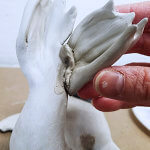



When mixed with slip, makes a smooth textile that is piece of cake to use. As the product recommends, only mix this material with your slip, do not add extra water or the crevice will re-announced as it dries. Tin use fingers, rubber tool, or sandpaper to smooth. I found it easiest to employ with a brush, and so shine over the mend area with more than skid on the brush and smooth it with a prophylactic tool when it approaches leather hard.
BISQUED Outcome:


Cleft fill re-opened and a hairline crack is visible. Re-attachment looks polish and strong.
BISQUE REPAIR:








In their instructions, APT II recommends calcining slip fabricated with APT Ii by firing a pencil of it to cone 018. So, you are to crush that pencil into dust and mix with more APT Ii for mending bisque. This did piece of work okay for filling cracks. No thing what I tried notwithstanding, I could not get this method to piece of work for re-attaching broken pieces. It is similar trying to glue bisque together with wet sand. Ultimately, I resorted to re-attaching the broken pieces with Apt II mixed with green sideslip instead.
FIRED Outcome:

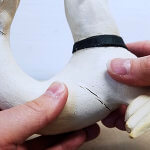


The dark-green-mended crevice has opened even farther. The bisque mended crack shows every bit a hairline crack merely did not re-open. I accidentally broke the green re-zipper fin when snapping off the bisque fin, so they both concluded upwardly getting bisque mended. Both bisque re-attachments did non laissez passer the "wiggle" examination, and broke off hands after the firing.
Lesser LINE: Much easier to apply on greenware, hard to use and non corking results for bisque mending. Seems more similar a slip thickener than anything. I found information technology about useful for repairing broken greenware every bit a Magic H2o alternative. It did not seem very effective at helping to fill cracks.
ARCHIE BRAY PATCH
Manufacturer: Archie Bray
Temperature: Δ04-10
Fired Colour: Bright white
Texture: Grainy paste
Notes: Can exist mixed with slip to aid colour match. I tried a 1:two slip to patch ratio, just that still yielded a very brilliant white fired result. Comes with warnings against sanding or grinding, although the clay business tech told me sanding with proper ventilation and a respirator is okay. Cannot freeze or information technology is ruined. Bray commonly will not ship this production betwixt October and April because of that.
GREENWARE REPAIR:






It was piece of cake to build smooth layers of this for crack filling and re-attachment. On greenware, any product sitting on tiptop of clay seems to have trouble adhering to it. When you shine or sand it, whatsoever product outside of the fissure pops off and falls away hands. This makes dark-green re-attachments fragile.
BISQUED RESULT:


Crack patch more often than not worked, merely a small hairline cleft re-appeared. Re-zipper, however, did not pass "wiggle" test later bisque and fell off easily.
BISQUE REPAIR:






I tried calculation some calcined clay dust to i of the bisque re-attachments for color matching. It sped up the drying time of material significantly, and seemed to still fire pretty white compared to the clay. Not sure this is worth information technology: it would probably exist easier simply to endeavour covering a Bray Patch mend with underglaze or glaze. Meanwhile, bisque mending with the textile on its own is easy and constructive. Piece of cake to smooth with a sponge or finger to cut down on the need to sand.
FIRED RESULT:




The light-green mended crack has an odd result: it seems similar the Bray Patch shrinks so little that the dirt actually shrunk around it, causing the mend to partially squeeze out from the crack and detach from it. Meanwhile, bisque mended crack worked the best of any material. The crack is visible only as a slight depression, and did not get a hairline scissure or re-open up. Bisque re-attachments await shine and strong.
BOTTOM LINE: This was my favorite material out of the grouping, equally it was easy to use, stayed smoothen and solid, and did non allow hairline cracks to reappear after the glaze firing. However it does seem to give ameliorate results when used at the bisque stage. It is not good for repairing greenware. Because information technology shrinks and so piddling, filling green cracks with information technology volition actually crusade more than bug afterwards on every bit the clay shrinks through two firings.
AZTEC HI-Burn MENDER
Manufacturer: Marx
Temperature: up to Δ10
Fired Color: Mixes with skid, so it matches your clay color
Texture: Peachy gel
GREENWARE REPAIR:






Makes a fluffy, "whipped" texture when mixed with sideslip. Every bit information technology dries, information technology shrinks into the crack or mend line and several layers need to be practical.
BISQUED Consequence:


Crack patch shows reappearance of hairline crack. Re-attachment seems smooth and potent.
BISQUE REPAIR:






While snapping off the fin to re-adhere, I accidentally snapped off the other fin and too broke the center seam apart completely. I used the mender to repair all three of these areas. Material behaved similarly every bit when repairing greenware, shrinking into the crevice line as information technology dried and needing multiple coats.
FIRED RESULT:




While all of the mends technically held together, the mending compound blistered and lifted away from the piece in a truly cruddy issue.
Lesser LINE: I didn't accept a lot of luck with this textile, except possibly as an aid when mending cleanly broken greenware. Doesn't seem very effective equally a bisque mend.
DUNCAN PATCH-A-TATCH
Manufacturer: Duncan
Temperature: Δ04
Fired Color: Ivory
Texture: Silky slip
Notes: The only depression-fire product I tested, this was bisqued to Δ06 with the other tests, and so glaze fired on its own to Δ04. Labeled "non-toxic."
GREENWARE REPAIR:






Frustrating to use on greenware as information technology dries extremely slowly, and every bit it dries, it shrinks repeatedly into the fissure or mend line. I found myself having to apply many coats and expect for a long time in betwixt for each coat to dry. I was able to test three other products in the time it took to wait and reapply sufficient coats of this i. Even then, a hairline fissure kept stubbornly re-appearing after the cloth dried.
BISQUED RESULT:


Sure enough, a harline crack was visible where I filled a crack in the greenish stage. The greenware mend, even so, stayed polish and stiff with minimal crack re-advent.
BISQUE REPAIR:






I accidentally broke the green-repaired fin while snapping off the bisque fin. (This by at present had emerged as unfortunate pattern, and a flaw in my test design program to accept these ii repair areas and so close together.) One time once more, the product took forever to dry and repeatedly shrunk into the crack or mend line, necessitating many coats of the material. Once enough of it is applied, it is easy to polish.
FIRED RESULT:




Green mended crack even so shows a hairline crack, but did not get much worse. Even so this may exist due to the fact that this is a lo-burn down production. It was glaze fired but to cone 04, non cone 6 like the other tests, and then it did not go through much more than shrinkage from the 06 bisque. Bisque mended fissure shows only a small hairline cleft re-emerged. Re-attachments seem strong, still a small hairline crack does show.
Bottom LINE: The tedious drying and loftier shrinkage of this product every bit it dried fabricated it frustrating to apply. I was able to re-attach pieces at both the green and bisque stages, merely hairline cracks emerged along these mends. It didn't perform well at all for filling cracks, which usually re-appeared as hairline cracks. This product may be all-time if used for small, make clean breaks and then covered with opaque glazes.
MARX MAGIC MENDER
Manufacturer: Marx
Temperature: Upward to Δ03
Fired Color: Ivory
Texture: Silky skid
Notes: Technically, this is another low fire product. Information technology is the depression fire analogue to Aztec Hi-Fire Mender, as well made past Marx. Notwithstanding that information was very hard to find. It is not listed on Marx' website, nor on the product labeling itself, nor could the staff at Marx tell me this data. I ultimately found the firing temp on Sheffield Pottery's production page for this product. Past then, information technology was too late and I had already coat fired this to Δ6. Comes with this alarm: "Peel and centre irritant. Harmful or fatal if swallowed."
GREENWARE REPAIR:






Comes as a runnier liquid than most of the other mending products. Considering of this, I constitute it necessary to build up many layers when filling cracks, every bit it shrinks into the fissure or mend line every bit information technology dries. When it approaches leather hard, it is like shooting fish in a barrel to smooth with a rubber tool.
BISQUED Effect:


Crack fill shows reappearance of hairline crack. Re-attachment seems shine and potent.
BISQUE REPAIR:




Aforementioned behavior as when used on greenware: runny material shrinks into the seam line equally it dries, necessitating several coats.
FIRED RESULT:




Greenish mended crack opened up quite a bit. Both the bisque mended scissure and the bisque mended re-attachment show hairline cracks along the seam line.
Lesser LINE: Some other material I didn't take much success with. It seems about constructive in helping repair cleanly broken greenware. Every bit a bisque mend, information technology allowed too many cracks to announced. Yet, I did technically over-burn this in the coat kiln, and then it may exist more constructive at its proper temperature range.
MR. Marking'S CRACK POT
Manufacturer: The Ceramic Shop in Philadelphia
Temperature: "High Fire"
Fired Color: Off-white, surrounded by a tan "halo"
Texture: Grainy paste with glace texture
Notes: This product comes in white, vitrify, and brown to help match your dirt body. I used white for this test. Information technology arrived separated and somewhat dry, and then I reconstituted it with a trivial bit of water and lots of stirring. The manufacturer recommends re-firing your piece to bisque temperature subsequently applying to bisque ware, for better sanding results and glaze adhesion. Comes with this alert label: "May cause slight irritation to individuals with sensitive skin. Wash hands with lather and water afterward employ. This product contains a chemical known to the state of CA to cause cancer. When sanding clay always use a dust mask. Do not ingest, proceed away from small children."
GREENWARE REPAIR:
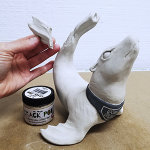

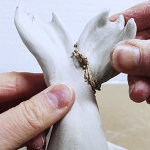
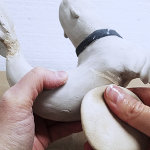
This material has a texture like wet sand, but with a slippery quality like sodium silicate. It dries fast and then y'all must work quickly. Filling cracks with information technology is fairly easy, you pack it into the fissure tightly with a rubber tool or plastic spatula. In fact, it is designed and marketed specifically as a scissure fill, not a reattachment production. For the purposes of this examination, I tried it anyway and sure enough, it was extremely difficult to employ for reattaching cleaved greenware. It was like trying to use wet sand equally glue. In one case information technology stale, it was too hard to smooth downward using whatever means. Pieces would simply fall off and the reattached pieces would come apart again.
BISQUED Effect:
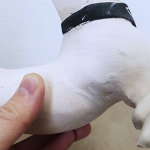
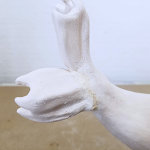
Crack is filled with little to no reappearance. Re-attachment held, simply is very messy due to the difficulty of smoothing this product downward without breaking the re-attachment.
BISQUE REPAIR:
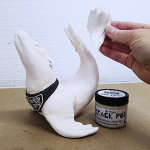



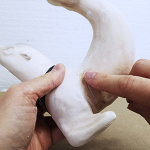
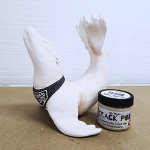
This was much easier to use on bisque than on greenware. Once again, filling cracks with this product was simple and like shooting fish in a barrel. For re-attachment, I plant that adding some water to the material seemed to assistance pieces stick together amend. The manufacturer recommends re-bisquing your piece after applying this product to it, for better sanding results and glaze adhesion. I skipped this stride, merely it may exist something wise to consider. When raw, the slippery, sodium silicate-like properties of this fabric will probably resist glaze or other surface treatments.
FIRED Result:
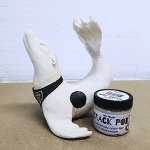
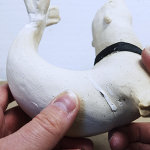

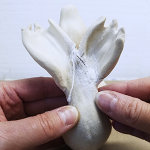
A similar odd result happened to the greenware patched crack as with the Bray Patch: the fissure seems to have shrunk more than than this mend material, causing the material to buckle and squeeze out from the mend line. The bisque patched crack seems decently closed, although a fine hairline fissure is still visible. However, this may take been mitigated by re-bisquing the piece, which the manufacturer recommends just I skipped. Green re-attachment is messy due to the fact that I couldn't clean it up very well. Bisque re-attachment looks ameliorate than expected, with minimal hairline cracks reappearing.
Bottom LINE: I'd say this product has ane very specific use: filling bisque cracks. It is easy to use and constructive for that purpose. Information technology can be used for bisque re-attachments, merely it is challenging and inconsistent, and information technology was not skillful at all for mending greenware. In fairness, this product is marketed equally a bisque scissure filler, and that information technology does very well.
MR. MARK'S WARE REPAIR
Manufacturer: The Ceramics Shop in Philadelphia
Temperature: Δ04-ten
Fired Color: Resembles a clear, heavily crazed glaze surrounded by an orange "halo"
Texture: Sticky, slippery liquid
Notes: Texture is very slippery, like sodium silicate. I suspect it is an ingredient in this product.
GREENWARE REPAIR:




It comes in a squeeze bottle and must exist used like superglue: squeezing a bead along the mend line and pressing the pieces together. As a crack make full, it was completely useless- but in fairness, it is non designed for that purpose. This is marketed equally a reattachment product. Yet, even for its intended use, I constitute this frustrating and hard to use. The slippery, liquidy product runs everywhere and is super sticky and hard to clean off. Backlog material dries in a flaky, brittle layer similar shellac that is hard to remove.
BISQUED RESULT:


Crack make full revealed a crispy, flaky mess. Reattachment completely failed "jerk" test and bankrupt apart hands.
BISQUE REPAIR:




While snapping off the fin for the bisque mend test, I accidentally broke the entire piece in half. Then, I used this product to reattach all 3 instances of breakage. It works much better in instances of perfect breaks: if holes or small shards are missing, information technology cannot fill up them. Once again this production was messy and frustrating to apply, running everywhere and sticking to everything it touched.
FIRED RESULT:



Not a single mend worked. This piece came out of the glaze kiln in iv divide pieces, with a shiny, crazed coat-like surface everywhere the production was applied.
Bottom LINE: My least favorite product on this list. Information technology was messy, frustrating to utilize, and didn't work on even ane of my test mends.
SPECTRUM MENDING PASTE
Manufacturer: Spectrum
Temperature: Δ04-6
Fired Color: White
Texture: Silky slip
Notes: On the manufacturer's website, information technology says this product "does not develop strength until after information technology is fired." Is labeled "Pb free, non toxic, dinnerware safe."
GREENWARE REPAIR:
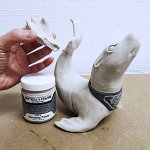



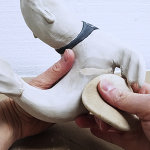

Runny but very smooth. Information technology is like shooting fish in a barrel to use, and every bit it approaches leather hard, it can be smoothed with a rubber tool or sanded down when dry.
BISQUED RESULT:


A very fine hairline crack reappeared in the crack fill. Reattachment stayed together and seems smoothen and stiff.
BISQUE REPAIR:




When I took this piece out of the bisque kiln, a hairline crack had appeared around the entire midsection of the piece. Instead of breaking it open and mending the two halves, I decided to fill the scissure with this material and run across how it went. Re-attachments and crack fill went fairly smoothly on bisque. The production dries very firm without much shrinkage. When smoothing down this product, it is better to sand or scrape rather than sponging, which removes too much of this material likewise quickly.
FIRED RESULT:



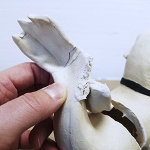
I was surprised to find a fairly poor result in the glaze kiln, as this material was pleasant to use and had given promising results thus far. The hairline crack I had filled had grown to split the piece almost fully in half, and the greenware re-attachment had completely disconnected. Since this textile vitrifies slightly at cone 6, the piece that had come discrete had then slid down and stuck itself back onto the piece with some of the vitrified mend material. The bisque mend besides showed the beginnings of separation.
BOTTOM LINE: This material initially performed well when information technology came to re-attaching broken greenware. Every bit a crack fill, it wasn't as skilful. However, the expert results in the lower temperature firings literally savage autonomously in the cone 6 kiln. This material may have improve success at lower firing temperatures.
Determination: Out of all these materials, I liked Bray Patch the best, and Mr. Mark's Ware Repair the least. Still, information technology is difficult to make blanket comparisons between these materials, because many of them excelled at merely one of the tests, while failing others. For example, Apt Ii was best for re-attaching greenware, while Mr. Mark'due south Crack Pot was all-time at filling bisque cracks. Even Bray Patch, my favorite material, was ineffective at repairing greenware, or filling cracks at the green stage. For a concise wrap-up of all the results, check out this post. I might propose picking the specific products from the list that suit your needs, and it may end up that you go on more one on paw. Happy mending!
How To Use Amaco Bisque Fix,
Source: http://www.emilynickel.com/2019/03/test-lab-process-commercial-bisque-mend-products/
Posted by: tawneytobt1981.blogspot.com


0 Response to "How To Use Amaco Bisque Fix"
Post a Comment